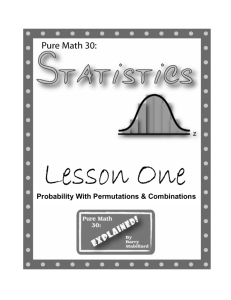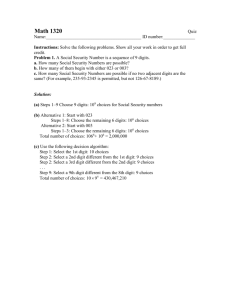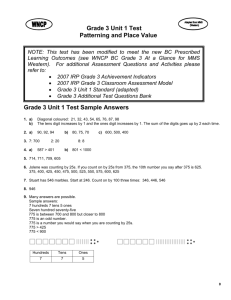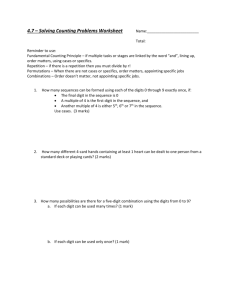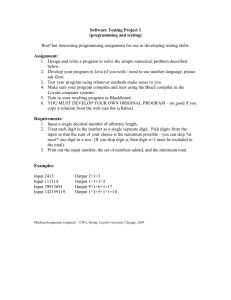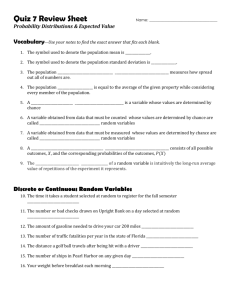PM12 - Probability Lesson 3
advertisement
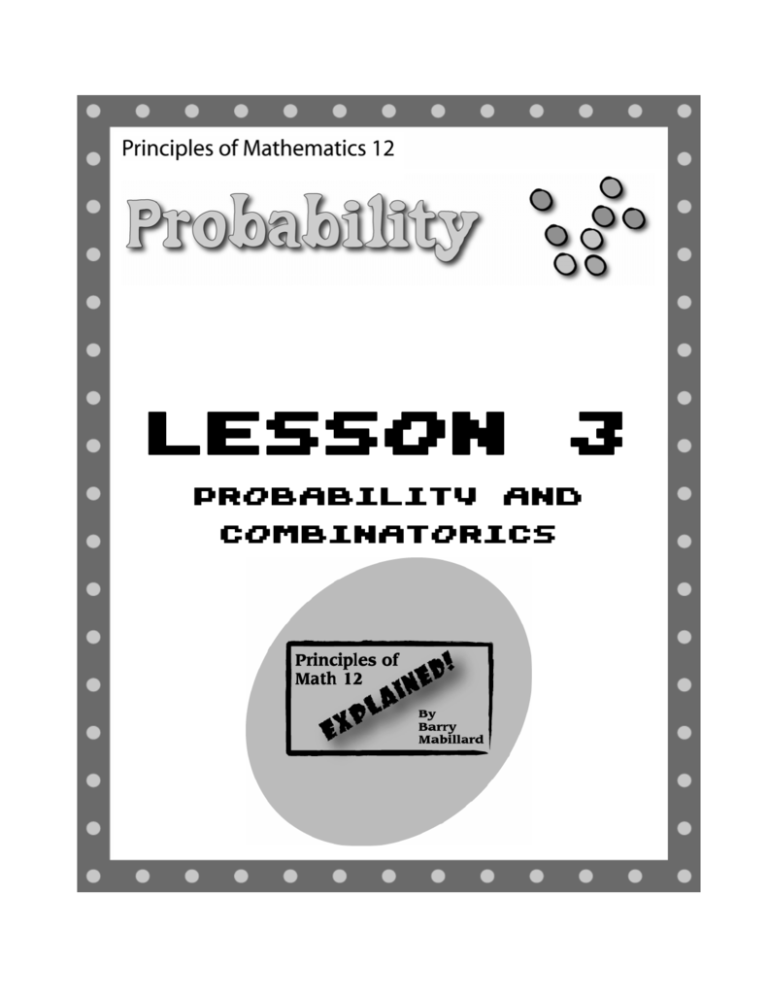
Lesson 3 Probability and Combinatorics Probability and Binomial Distributions Principles of Mathematics 12: Explained! www.math12.com 333 Probability Lesson 3 Part 1: Basic Probability Basic Probability: When pulling a single item from a set, use basic probability. Probability = Number Of Favorable Outcomes Total Possible Outcomes Example 1: A bag contains three red balls and four green balls. One ball is pulled out. What is the probability of: a) Pulling out a red ball? The number of favorable cases is 3, since there are three red balls. The total number of cases is 7, since there are seven balls altogether. 3 The probability of pulling out a red ball is . 7 b) Pulling out a green ball? The number of favorable cases is 4, since there are four green balls. The total number of cases is 7, since there are seven balls altogether. 4 The probability of pulling out a green ball is . 7 c) Pulling out a blue ball? The probability is zero, since there are no blue balls. Example 2: A letter is selected from the word STATISTICS. What is the probability the letter is an S or a T ? There are three S’s and three T’s, leading to six favorable outcomes. There are ten letters 6 altogether. The probability of pulling an S or a T is = 0.6 0 10 Questions: 1) A jar contains 22 marbles. 4 are red, 3 are green, 7 are blue, and 8 are yellow. If a single marble is pulled out of the jar, find the probability of pulling: a) a red marble b) a blue or yellow marble Answers: 1) a) A red marble has a probability of selection of 4 = 0.18 22 c) not green 7 b) A blue or yellow marble has a probability of selection of 22 d) purple 8 + 15 = 22 = 0.68 22 (Remember that “or” means to add probabilities together.) c) 19 marbles are not green, so the probability of getting one of these is 19 = 0.86 22 d) Since there are no purple marbles, the probability is zero. Principles of Mathematics 12: Explained! www.math12.com 334 Probability Lesson 3 Part 2: Probability With FCP & Permutations Probability involving Fundamental Counting Principal & Permutations Example 1: A 5 digit PIN number can begin with any digit (except zero) and the remaining digits have no restriction. If repeated digits are allowed, find the probability of the PIN code beginning with a 7 and ending with an 8. First determine the number of possible arrangements for the PIN number that satisfy the stated restrictions. There is only one possible digit for the first & last positions, and the middle positions can be any digit. Now determine the total number of arrangements The first digit can’t be zero The probability is 1000 1 = 90000 90 Example 2: Three different DVD’s and their corresponding DVD cases are randomly strewn about on a shelf. If a young child puts the DVD’s in the cases at random, determine the probability of correctly matching all DVD’s and cases. Method 1: Draw out the possible cases: There is only one favorable outcome out of six possible outcomes. 1 The answer is 6 Method 2: There is only 1 favorable outcome out of 3! = 6 possible outcomes. Favorable outcomes 1 1 = = Total possible outcomes 3! 6 Example 3: A security code consists of 8 digits, which may be any number from 0 to 9. Repetitions are allowed. Determine the probability a particular code begins with exactly two 7’s, to the nearest hundredth. The first two digits must each be 7, so there is only 1 possibility for each position. The third digit must NOT be 7, so there are 9 possibilities. The remaining digits can be anything from 0 – 9, so there are 10 possibilities. There are 108 = 100 000 000 arrangements without restrictions. 900000 The probability is = 0.009 = 0.01(Rounded) 100000000 Principles of Mathematics 12: Explained! www.math12.com 335 Probability Lesson 3 Part 2: Probability With FCP & Permutations Example 4: There are 12 male athletes and 14 female athletes competing in a marathon. Find the probability of three different prizes being awarded to all males or all females. The ways the top three prizes can go to men or women is P +14 P3 = 3504 12 3 (Use permutations since the prizes are different, adding since the groups are independent.) The number of ways three prizes can be ordered randomly is 26 P3 =15600 The probability is 3504 = 0.2246 15600 Example 5: Kevin, Rachel, and 6 other students are standing in a line. Determine the probability Kevin and Rachel are not standing together. The number of lines with Kevin and Rachel not standing together is 8!- ( 7!•2!) = 30240 The number of lines without restrictions is 8! = 40320 30240 The probability is = 0.75 40320 Questions: 1) A 4 digit PIN number can begin with any digit (except zero) and the remaining digits have no restriction. If repeated digits are allowed, find the probability of the PIN code beginning with a number greater than 7 and ending with a 3. 2) A security code consists of 6 digits, which may be any number from 0 to 9. The code can begin with any digit (except zero). No repetitions are allowed. Determine the probability a particular code begins with an even digit, to the nearest hundredth. 3) Jeff, Amy, and 5 other students are standing in a line. Determine the probability Jeff and Amy are standing together. 4) Jeff, Amy, and 5 other students are standing in a line. Determine the probability Jeff and Amy are not standing together. 5) There are 7 accountants and 4 marketing agents at a conference. Find probability of three different door prizes being awarded to all accountants or all marketing agents. Principles of Mathematics 12: Explained! www.math12.com 336 Probability Lesson 3 Part 2: Probability With FCP & Permutations Answers: 1) There are 2 possibilities for the first digit. (8 or 9) There are 10 possibilities for each of the middle digits (any number) There is only one possibility for the final digit. (Must be 3) Multiply together to get the favorable cases: 2 • 10 • 10 • 1 = 200 The total possible cases are 9 • 10 • 10 • 10 = 9 000 The probability is 200 9000 = 0.022 2) There are 4 possibilities for the first digit. (2, 4, 6, or 8 Æ Remember that zero is excluded) There are 9 possibilities for the next digit (since we have used up a number) then 8 possibilities for the next digit, then 7, then 6, then 5 possibilities for the last digit. Multiply together to get the favorable cases: 4 • 9 • 8 • 7 • 6 • 5 = 60480 The total possible cases are 9 • 9 • 8 • 7 • 6 • 5 = 136080 The probability is 60480 136080 = 0.444 3) Jeff and Amy can stand together in 2! • 6! = 1440 different ways The number of possible lines without restrictions is 7! = 5040 The probability is 1440 5040 = 2 7 = 0.29 4) Jeff and Amy do not stand together in 7! – (2! • 6!) = 3600 different ways The number of possible lines without restrictions is 7! = 5040 The probability is 3600 5040 = 5 7 = 0.71 (You could also use: Probability of not standing together = 1 – probability of standing together.) 5) The ways the top three prizes can go to accountants or marketing agents is 7 P3 +4 P3 = 234 (Use permutations since the prizes are different, adding since the groups are independent.) The number of ways three prizes can be ordered randomly is 11P3 = 990 The probability is 234 = 0.236 990 Principles of Mathematics 12: Explained! www.math12.com 337 Probability Lesson 3 Part 3: Probability With Combinations Probability With Combinations: When pulling multiple items from a set, use combination probability. Example 1: A bookcase contains 6 different math books and 12 different physics books. If a student randomly selects two of these books, determine the probability they are both math or both physics books. The number of ways to select two math books or two physics books is 6 C2 + 12C2 = 81 The number of ways to select any two books is 18 C2 = 153 The probability is 81 9 = 153 17 Example 2: A jar contains 5 orange, 3 purple, 7 blue, and 5 green candies. If the total number of candies is 20, determine the probability that a handful of four candies contains one of each color. The number of ways to select four candies, such that one from each color is obtained, is 5 C1 ×3 C1 ×7 C1 ×5 C1 = 525 . (Multiply since you are creating one set using items from multiple sets) The total number of ways to select four candies is C× C× C× C 525 The probability is 5 1 3 1 7 1 5 1 = = 0.108 4845 20 C4 20 C4 = 4845 Example 3: A committee of 4 people is to be formed from a pool of 8 people. What is the probability James is on the committee? If James is on the committee, this reduces the pool of people to 7, and 3 remain to be selected. The committees with James is 7C3 = 35, and the total possible committees is 8C4 = 70 The probability James is on the committee is: 35 = 0.5 70 Example 4: Seven males and nine females are in a selection pool for a committee of 4 people. What is the probability at most 3 males are on the committee? The easiest way to do this is to use: 1 – (Probability of 4 males on the committee) 4 males can be chosen in 7C4 = 35 ways, and the total possible cases are 16C4 = 1820. Probability = 1- 35 1820 = 1785 1820 = 0.9808 Principles of Mathematics 12: Explained! www.math12.com 338 Probability Lesson 3 Part 3: Probability With Combinations Example 5: Lotto 7-45 has 45 numbers you can choose from, and you must pick 7. If a free ticket is given out by matching 2 correct numbers, what is the probability of getting this particular prize? Out of the 7 winning numbers, 2 must be picked. 7C2 = 21 Of the 38 non-winning numbers, 5 must be picked. 38C5 = 501942 Number of favorable cases is 7C2 •38C5 = 10540782, Total number of cases is 45C7 = 45379620 The probability of winning a free lottery ticket is: 10540782 45379620 = 0.2323 Example 6: In the card game Bridge, 4 players are each given a hand of 13 cards. a) What is the probability a player receives all the kings? A hand can contain all 4 kings (and 9 other cards) in 4C4 • 48C9 ways. The total ways a 13 card hand can be dealt is 52C13. Probability of receiving all kings = 4 C4 • 48 C9 = 52 C13 11677106640 635013559600 = 0.026 b) What is the probability a player does not have any 2’s? A hand can contain no 2’s in 48C13 ways. C 192928249300 Probability of receiving no 2’s is 48 13 = = 0.30 C 52 13 635013559600 c) What is the probability a player receives at least 3 queens? A hand can contain 3 or 4 queens in 4C3•48C10 + 4C4•48C9 ways. C • C + C • C 27839970220 Probability = 4 3 48 10 4 4 48 9 = = 0.044 C 52 13 635013559600 d) What is the probability a player receives two 4’s, four 6’s, three 7’s, three 10’s, and an ace? This hand can be selected in: 4C2 • 4C4 • 4C3 • 4C3 • 4C1 ways. C • C • C • C • C Probability = 4 2 4 4 4 3 4 3 4 1 = C 52 13 384 635013559600 = 0.00000000060 Principles of Mathematics 12: Explained! www.math12.com 339 Probability Lesson 3 Part 3: Probability With Combinations Questions: 1) A jar contains 2 white marbles and 5 green marbles. Three marbles are drawn simultaneously. What is the probability that: a) two marbles are green? b) at least two marbles are green? c) no white marbles are drawn? 2) A school committee of 5 members is to be formed from a selection pool of 9 boys and 7 girls. What is the probability that: a) all boys are on the committee? b) there are 2 boys and 3 girls on the committee? c) the girls form a majority? d) Jane is on the committee, and there is no other restriction? e) Brian is on the committee, but Nathan is not, with no other restriction? 3) Five males and six females are in a selection pool for a committee of 3 people. What is the probability at most 2 males are on the committee? 4) In a sample of households with a vehicle, four owned a truck and five owned a car. If three households were randomly selected from the sample, calculate the probability that two would have a car and one would have a truck 5) In a five card hand from a deck of 52 cards, what is the probability of receiving: a) four aces? b) three 10’s c) at most one queen? d) at least three black cards? Principles of Mathematics 12: Explained! www.math12.com 340 Probability Lesson 3 Part 3: Probability With Combinations Answers: C • C 20 1) a) Two green marbles and one white can be selected in 5C2 • 2C1 ways. Probability is 5 2 2 1 = 7 C3 35 = 0.5714 b) We need the cases of 2 green marbles being drawn or 3 green marbles being drawn. This can be done in 5C2 • 2C1 + 5C3 ways. Probability is C • C + C 5 2 2 1 5 3 = 30 = 0.8571 35 7 C3 C 5 3 = 10 = 0.2857 35 7 C3 c) No white marbles means all green marbles, and can be drawn in 5C3 ways. Probability is 2) a) all boys can be selected in 9C5 ways. Probability is 9 C5 16 C5 = 126 4368 = 0.02885 9 C2 • 7 C3 b) Two boys and three girls can be selected in 9C2 x 7C3 ways. Probability is 16 C5 c) the girls can form a majority if there are 3 girls (2 boys), 4 girls (1 boy) or 5 girls. This can be done in 7C3 • 9C2 + 7C4 • 9C1 + 7C5 ways. Probability is 1260 = 4368 7 C3 • 9C2 + 7C4 • 9C1 + 7C5 16 C5 = 0.2885 = 1596 4368 = 0.3654 d) If Jane is on the committee, we have 15 people left to select from, and 4 positions to fill. 15C4 15 C 4 = 1365 = 0.3125 4368 16 C5 e) If Brian is on the committee, but Nathan is not, we have 14 people left to select from, and 4 positions to fill. 14C4 Probability is Probability is 14 C4 16 C5 = 1001 4368 = 0.2292 3) The easiest way to do this calculation is to use: Probability of at most 2 males = 1 – Probability of 3 males Probability of at most 2 males = 1- 5 C3 = 0.9393 11C3 4) The number of cases with two cars and one truck is 5 C2 ×4 C1 = 40 The total number of cases is C = 84 9 3 The probability of 2 cars and 1 truck is 5) a) Four aces can be in a hand in 4C4 • 48C1 ways. Probability is b) Three tens can be dealt in: 4C3 • 48C2 ways. Probability is 4 C4 x 48 C1 52 C5 4 C 3 x 48 C 2 52 C5 = = 48 2598960 4512 2598960 40 84 = 0.476 = 0.000018 = 0.0017 c) At most one queen means we need the cases of no queens, and one queen. C5 + 4 C1 • 48 C4 2490624 = = 0.96 This can be done in 48C5 + 4C1• 48C4 ways. Probability is 48 52 C5 2598960 d) We need the cases of three black cards (and two red), four black cards (and one red), and five black cards. This can be done in 26C3 x 26C2 + 26C4 x 26C1 + 26C5 ways. C x C + C x C + C 1299480 = 0.5 Probability is 26 3 26 2 26 4 26 1 26 5 = 52 C5 2598960 Principles of Mathematics 12: Explained! www.math12.com 341

